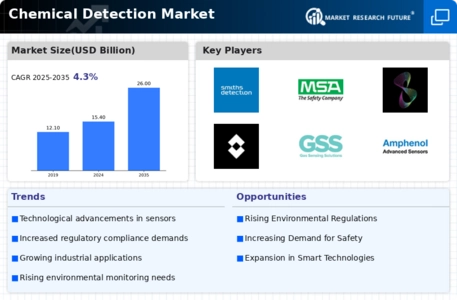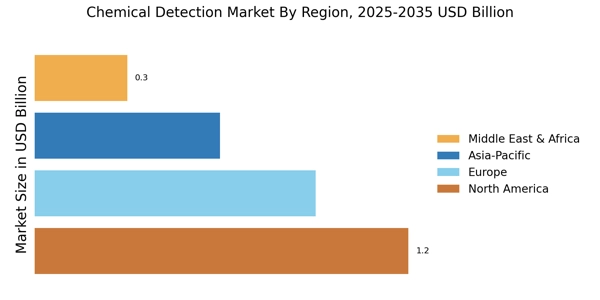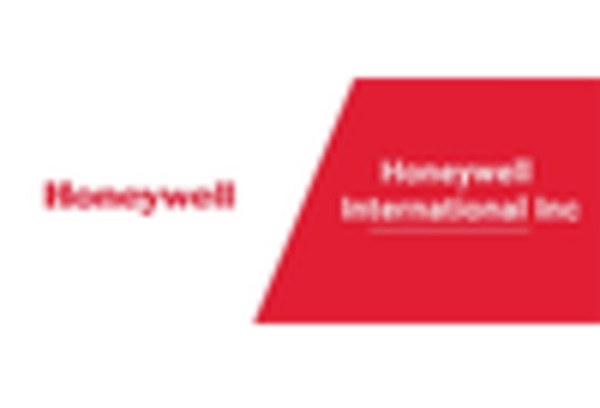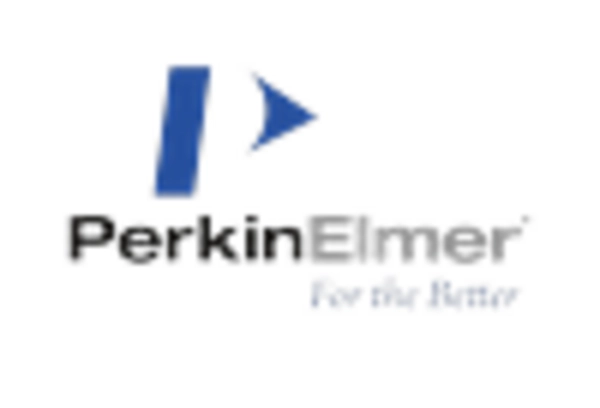Technological Advancements
Technological advancements play a pivotal role in shaping the Chemical Detection Market. Innovations in sensor technology, data analytics, and artificial intelligence are enhancing the capabilities of chemical detection systems. For example, the development of miniaturized sensors allows for real-time monitoring and detection of hazardous chemicals in various environments. This not only improves safety but also increases operational efficiency. The integration of AI algorithms enables predictive analytics, which can identify potential chemical threats before they escalate. As these technologies continue to evolve, they are likely to attract investments and drive market expansion. The market is anticipated to witness a growth rate of around 8% annually, fueled by the demand for more sophisticated detection solutions.
Rising Regulatory Standards
The Chemical Detection Market is experiencing a surge in demand due to increasing regulatory standards across various sectors. Governments and regulatory bodies are implementing stringent guidelines to ensure safety and compliance, particularly in industries such as pharmaceuticals, food and beverage, and environmental monitoring. For instance, the introduction of regulations regarding hazardous substances has necessitated the adoption of advanced chemical detection technologies. This trend is expected to drive market growth, as companies seek to comply with these regulations and avoid penalties. The market for chemical detection solutions is projected to reach USD 5 billion by 2026, reflecting a compound annual growth rate of approximately 7% from 2021 to 2026. As a result, the need for reliable and efficient detection systems is becoming increasingly critical.
Growing Environmental Concerns
Growing environmental concerns are driving the Chemical Detection Market as stakeholders seek to address pollution and contamination issues. The need for effective monitoring of hazardous chemicals in air, water, and soil has become paramount, prompting governments and organizations to invest in chemical detection technologies. This trend is particularly relevant in the context of climate change and sustainability initiatives, where the detection of pollutants is essential for regulatory compliance and environmental protection. The market is expected to witness a growth rate of approximately 7% per year, as more entities recognize the importance of chemical detection in preserving ecosystems and public health. As a result, the demand for innovative detection solutions is likely to increase.
Expansion of End-User Industries
The expansion of end-user industries is a crucial driver for the Chemical Detection Market. Sectors such as agriculture, pharmaceuticals, and food processing are experiencing robust growth, leading to an increased demand for chemical detection solutions. For instance, the agricultural sector requires effective detection systems to monitor pesticide residues and ensure food safety. Similarly, the pharmaceutical industry relies on chemical detection technologies to maintain product quality and compliance with health regulations. This expansion is likely to create new opportunities for market players, as they develop tailored solutions to meet the specific needs of these industries. The market is projected to grow at a rate of 6% annually, reflecting the increasing reliance on chemical detection across various sectors.
Increasing Awareness of Safety and Security
The Chemical Detection Market is significantly influenced by the growing awareness of safety and security among industries and consumers. As incidents of chemical spills, leaks, and contamination become more prevalent, organizations are prioritizing the implementation of chemical detection systems to safeguard their operations and the environment. This heightened awareness is particularly evident in sectors such as manufacturing, healthcare, and transportation, where the consequences of chemical exposure can be dire. The market is projected to grow as companies invest in detection technologies to mitigate risks and enhance their safety protocols. In fact, the market is expected to reach USD 4.5 billion by 2025, driven by the increasing emphasis on safety measures.

















Leave a Comment